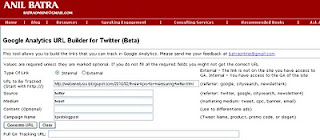KPI: % Visit Rate = (Visits/Followers)*100))
Measuring VR the wrong way
- Referring Sites/Domains Report
Late last year I did a small survey to understand how people measure the success of the links they post on Twitter. I found out that most of the people rely on “Referring Sites/Domains” report in their web analytics tool to see the traffic they get from Twitter. This seems like a great approach but there are two problems with this:
- Twitter.com is not the only way to access Twitter. A lot of people use 3rd party tools like Tweetdeck to access Twitter. A click on a link from such a tool won’t show up in the “Referring Sites/Domains” reports in the web analytics tool, it will be listed as “Direct Traffic” or “No referrer”.
- You can’t see the how each individual link (tweet) performed. Without this information, how do you know what works and what does not? How do you know what words trigger your followers interest?
- Click count from URL shorteners
Some Twitterers rely on their URL shortening service, e.g. bit.ly, clop.in, cli.gs etc. to measure the success of the links they post on Twitter. They look at the clicks they get on the links. By using the click count from URL Shortener you can overcome the two limitations that I mentioned above. However, the URL shorteners usually count clicks and not the actual visits/visitors. Which means that they, not only capture human clicks but also the clicks from spider/bots, thus inflating the actual numbers of visits/visitors. And trust me there are several bots/spiders crawling twitter feeds and links.
Another problem with using URL shorteners reporting is that they only capture the clicks and the sources but they do not provide any post click data on the visitors. To fully understand the impact of your tweets on our site or business, only counting the clicks or visits/visitors is not enough. You have to go beyond that. You have to understand how visitors interact with your site and if they take the desired actions or not.
Measuring VR the right way
To get an accurate count of the visits resulting from a link posted on Twitter, use your web analytics tool campaign tracking capability. Treat every link posted on Twitter as a new campaign. Tag the links with the campaign variables so that you can track in your web analytics tool.
When you treat the links posted on Twitter as campaign, you will not only get the clicks but also the visitors/visit count as reported by your web analytics tool. % VR can then be calculated by dividing the visits by the twitter followers.
(Note: Ideally you would want to measure Visitors instead of Visits but depending on your tool and considering cookie deletion you might not get an accurate count of Visitors).
Tagging the URLs with campaign variables
Let’s say, I want to post a link to my last blog post on Twitter. Instead of simply posting a link http://webanalysis.blogspot.com/2010/02/three-kpis-for-measuring-twitter.html, I will append campaign variables so that I can track the performance in my web analytics tool.
Since I use Google Analytics on my blog, I will use Google Analytics campaign tracking. In order to track my URL as a campaign, I will add three query parameters, utm_source, utm_medium, and utm_campaign to the URL.
I usually set the utm_source to “twitter” , utm_medium to tweet and utm_campiagn to a value that represents the content of my tweet.
The final URL that I will post on twitter will be
http://webanalysis.blogspot.com/2010/02/three-kpis-for-measuring-twitter.html?utm_source=twitter&utm_medium=tweet& utm_campaign=twitterkpi
Using a unique value for utm_campaign will allow me to not only know how much traffic is driven by twitter but also which tweets are driving the traffic. I can also create a custom segments in Google Analytics and analyze all my data for these segments.
The following site has 100 twitter followers so their %VR ranges from 1% - 6%. If you tie this information with the actual message in tweet, time of tweet, day of the tweet etc. you can figure out what works for the followers. By creating the segments you can slice any report in Google Analytics to see how visitors are interacting with the site.
To make it easier for you to add these variables, I have a simple Google Analytics campaign URL builderon my site that should help you to easily tag your links with the campaign variables for Google Analytics before you post them on Twitter. I might add support for other major web analytics tools in future.
Questions? Comments?
Looking to fill your Web Analytics or Online Marketing position?
Post your open jobs on Web Analytics Job Board
Senior Manager, Business Intelligence & Web Analytics at Freshdirect (Long Island City, NY)
Internet & Intranet Systems Programmer/Analyst at American Dental Association (Chicago, IL)



Anil, great post and I look forward to more of tracking Twitter. Any thoughts on the impact of Retweets on the VR metric? Using Followers as the denominator provides a possibility of the ratio being greater than 100%. Seems like this is similar to an Impression-to-Click ratio and ideally would include all views of the Tweet rather than just follwers.
ReplyDeleteCasey
I like this idea. But it seems to make a really long URL. Wouldn't I have to shorten the URL (tinyurl, etc)? Would that have an impact on the measurements?
ReplyDeleteRon
Casey,
ReplyDeleteYou are right, the total impression can be and will be more than the followers but there is no way that I know of to track actual impressions. Retweet is not the only issue, many people resort to search even if they don't follow you they might see and click on your link.
Anil
Ron,
ReplyDeleteYes you will need to shorten the URL. It won't have any impact on the measurement.
Anil
Good insight Anil. I'm new to this field and looking forward to learn a lot from you. Has started following you on twitter
ReplyDeleteNice post, Anil! Wish more folks were using campaign tracking.
ReplyDelete